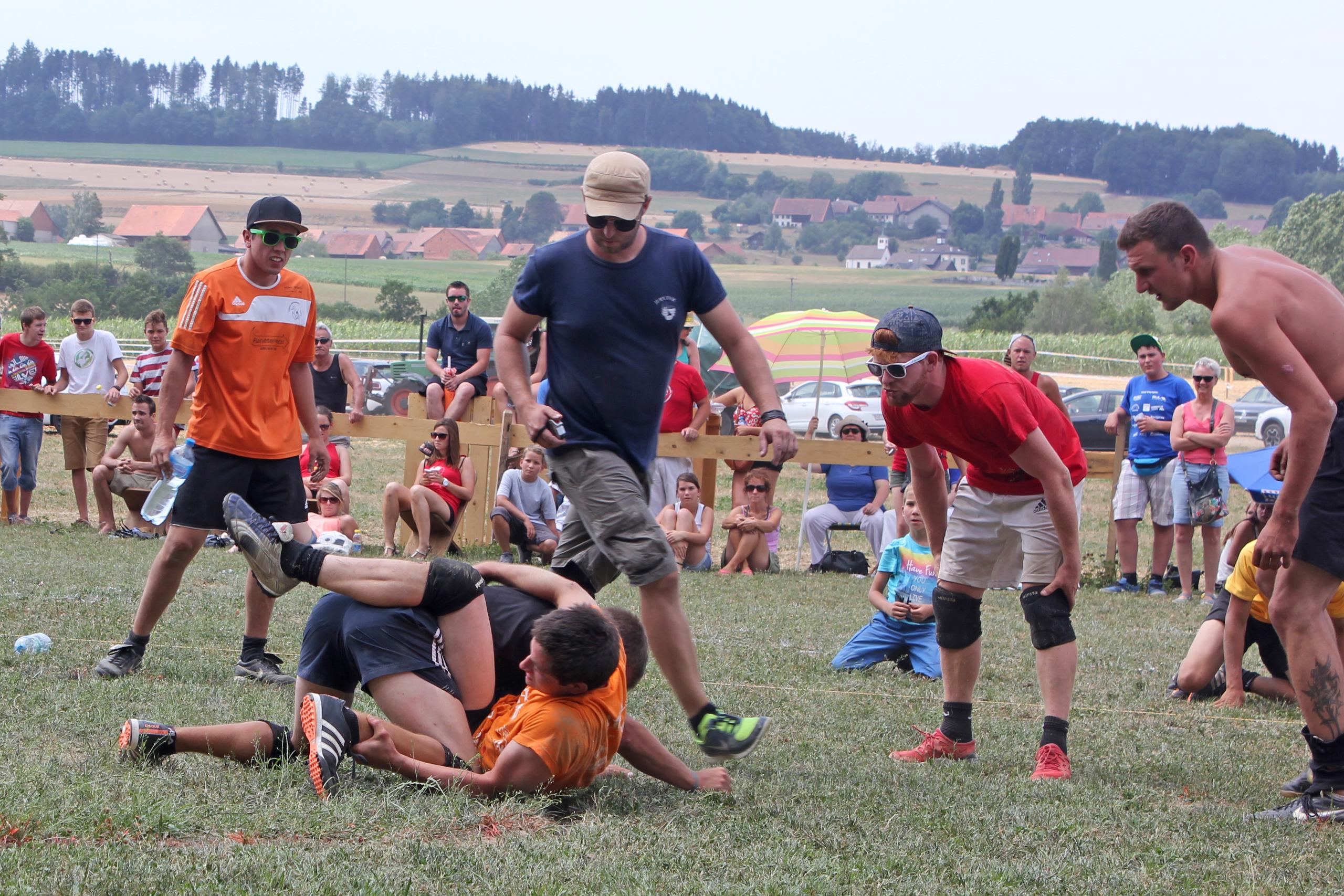
Rural youth festivals: social glue or harmful drinkfests?

Rural youth associations are a veritable institution in the Swiss cantons of Vaud and Fribourg, despite – or possibly because of – their reputation as places to load up on beer and wine.
Founded at the beginning of the 20th century to protect the interests of farming communities, the “giron”, or country fair, with its festive atmosphere and sporting events is an opportunity for young people to show their support for village life and traditions.
Elodie Milando breaks all clichés: while rural youth associations are known to be rather macho, conservative, patriotic and closed to the outside world, this young woman of Italian origin has been propelled to the fore of the Giron de la Broye, one of the four big fairs that liven up the Vaud countryside throughout the summer.
“It all started with a slightly crazy idea,” she tells swissinfo.ch. “Our youth association has only 15 members, but we were convinced that if others were capable of organising a giron, then so were we. However, no one wanted to be president of the organising committee…”
So Milando took the plunge. With a budget of CHF250,000 ($260,000) for five days of events, 1,400 volunteers to organise and over 30,000 visitors expected, the challenge was enough to daunt even the bravest.
“Fortunately, we knew we could count on other youth associations for their support,” she says.
Meticulous organisation
The results are impressive. At the centre of the festival site, which is set up on agricultural land belonging to the commune of Cremin, is the drinks pavilion. This circular bar forms the nerve centre of the festival and is directly fed with thousands of litres of beer via an underground pipe connected to a tanker stationed outside.
From the car park to the campsite to the food stands under the giant marquee, everything has been organised down to a tee.
Appropriate grounds have been carefully prepared for the different sports events – football, volleyball, athletics, pétanque, wrestling and tug-of-war – which are expected to receive nearly 2,000 participants over the five days, both around the festival site and in the neighbouring village of Lucens, which already had the necessary infrastructure.

More
Young, rural, athletic and thirsty
Festive spirit
Work, solidarity, friendship and a festive spirit: this is what motivated Milando and her friends to embark on this extraordinary adventure.
It is also the recipe for the success of the Vaud Federation of Rural Youth Associations. While clubs across Switzerland often complain about a lack of commitment and falling membership, the Vaud youth associations are unscathed by the crisis.
Today the Vaud federation has over 8,100 members, compared with 5,300 in 1999, and 207 active associations.
“The evolution of society has rekindled the need for a different kind of sociability, a conviviality that is more immediate and more human, at a time when many people are seeking to move back to the land,” says Vaudois historian Olivier Meuwly.
Set up in 1919 to fight the rural exodus and defend farmers’ interests but also to prevent the rise of Bolshevism, over time the federation has set aside political issues in favour of festive and sporting goals. It has managed to adapt to the rapid transformation of rural life in Vaud, marked by a decline in farming activities and rapid population growth in the villages with the arrival of what sociologists call “neo-rurals”.
Young people at work
“In the German-speaking part of Switzerland, the ‘Landjugend’ (rural youth) is still almost exclusively intended for young farmers. In our association, all professions are represented in a proportion that reflects the new socio-economic situation of our countrysides,” explains Cédric Destraz, vice-president of the Vaud federation and an electrician by training.
The sociologist Alexandre Dafflon, who has just written a bookExternal link about these youth associations, is also convinced that this opening up has helped secure the federation’s future. He points out, nonetheless, that while the girons attract an increasingly diverse public, this does not mean that everyone joins a youth association.
“Most members have a relative who is already part of the association. Moreover, the manual trades are highly valued, particularly among the men. The youth associations want to project the image of young people at work, and this must above all be useful, concrete and visible – university being what is furthest removed from this vision,” he says.
Respect for hierarchy
Elodie Milando is proof that women now have their place within the rural youth associations. But she has also come up against some entrenched prejudices.
“While we were preparing for the festival, I saw that everyone had a well-defined role: the boys were in charge of setting up the installations and the girls did the decorations. Don’t try to give a drill to a girl or a paintbrush to a boy…”
Customs and respect for tradition and hierarchy are core values that are part of daily life in this community of young men and women.
“In our association, the youngest member always has to serve the aperitifs, for example,” says Cédric Destraz.
Tarnished reputation
Certainly, both beer and wine are everywhere and act as a powerful social binder.
“Having a drink with a neighbour or a local farmer is a way of asserting that you are part of the community,” writes Alexandre Dafflon.
“And you can’t just drink any old how – there is a set way of doing things. For instance, drinking alcohol on your own is highly frowned upon.”
Still the girons, some of which have taken on gigantic proportions in recent years, are struggling to shake off their reputation as huge drinking bashes, despite the federation’s efforts to raise awareness of the risks.
This can tarnish the image – which the federation tries to promote – of a healthy, upstanding young generation with a positive approach to life, as opposed to an urban youth which is supposedly individualistic and disoriented.
Cédric Destraz, meanwhile, prefers to stress the importance of the youth associations for village life in the Vaud.
“By organising events throughout the year, we prevent our villages from becoming mere dormitory suburbs. Also, aren’t young people here also entitled to party, as others do in the nightclubs of Lausanne or at music festivals? When we’ve slaved for months to set up the infrastructure for a giron like the one in La Broye, we can also let our hair down and have a bit of fun, can’t we?”
Samuel Jaberg, Cremin, swissinfo.ch
Translated from French by Julia Bassam

In compliance with the JTI standards
More: SWI swissinfo.ch certified by the Journalism Trust Initiative



























You can find an overview of ongoing debates with our journalists here . Please join us!
If you want to start a conversation about a topic raised in this article or want to report factual errors, email us at english@swissinfo.ch.